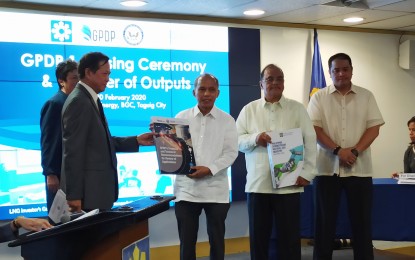
CLEAN POWER SOURCES. Energy Secretary Alfonso Cusi receives one of the documents completed under the Gas Policy Development Project (Phase 1) on Thursday (Feb. 20, 2020) in Taguig City. The project aims to strengthen the country's clean energy resources. (PNA photo by Kris Crismundo)
MANILA -- The Department of Energy (DOE) concluded the first phase of the Gas Policy Development Project (GPDP-1) on Thursday with four deliverable documents handed over to the DOE.
DOE Secretary Alfonso Cusi received four documents completed under GPDP-1 namely: The Philippine Downstream Natural Gas Industry: LNG Investor’s Guide; GPDP’s Financial and Technical Recommendations for the Review of LNG Project Applications; Research Study on Market Profiling with Emphasis on the Use of Liquefied Natural Gas to Power Economic Zones; and the GPDP Completion Report highlighting the Project accomplishment for Phase 1.
Cusi highlighted the importance of producing the LNG Investor’s Guidebook to assist potential investors in identifying and securing necessary permits and clearances from government agencies. It also lists technical standards for them to comply with.
“This is aligned with the Duterte administration’s thrust to eradicate bureaucratic red tape and promote greater infrastructure development through measures such as Republic Act 11032, or the Ease of Doing Business Law, as well Executive Order No. 30 on Energy Projects of National Significance,” he said.
According to the guidebook, interested investors have to secure 138 permits coming from seven government agencies alone.
The DOE forged an agreement with the University of the Philippines Statistical Center Research Foundation, Inc. in December 2018 to start the United States-funded GPDP.
The GPDP helps the DOE to prepare policy recommendations that will promote clean power sources. It also aims to attract investments in LNG industry as resources from the Malampaya gas field are depleting.
“We need to become energy self-sufficient. A crucial component of this goal is strengthening our natural gas industry since unfortunately, we became complacent after Malampaya’s discovery,” the DOE chief said.
Oil Industry Management Bureau Director Rino Abad said the DOE aims to continue the second phase of the GPDP that will focus on delineation of listed technical standards on the construction of LNG regasification terminal and its associated agency.
Abad added it also targets to conduct workshops per agency that are involved in LNG operations and permitting as it pursues to streamline the 138 permits to as low as one permit per agency.
He said funding for the second phase of the project will come from the commitment of the United States Department of State by the next budget cycle and DOE’s allocation from the 2020 national budget.
The GPDP-2 will also tap technical support from existing studies of LNG industry, particularly UP College of Engineering and UP School of Economics, that have been accessing funds through the effort of the Senate energy committee, he added. (PNA)
